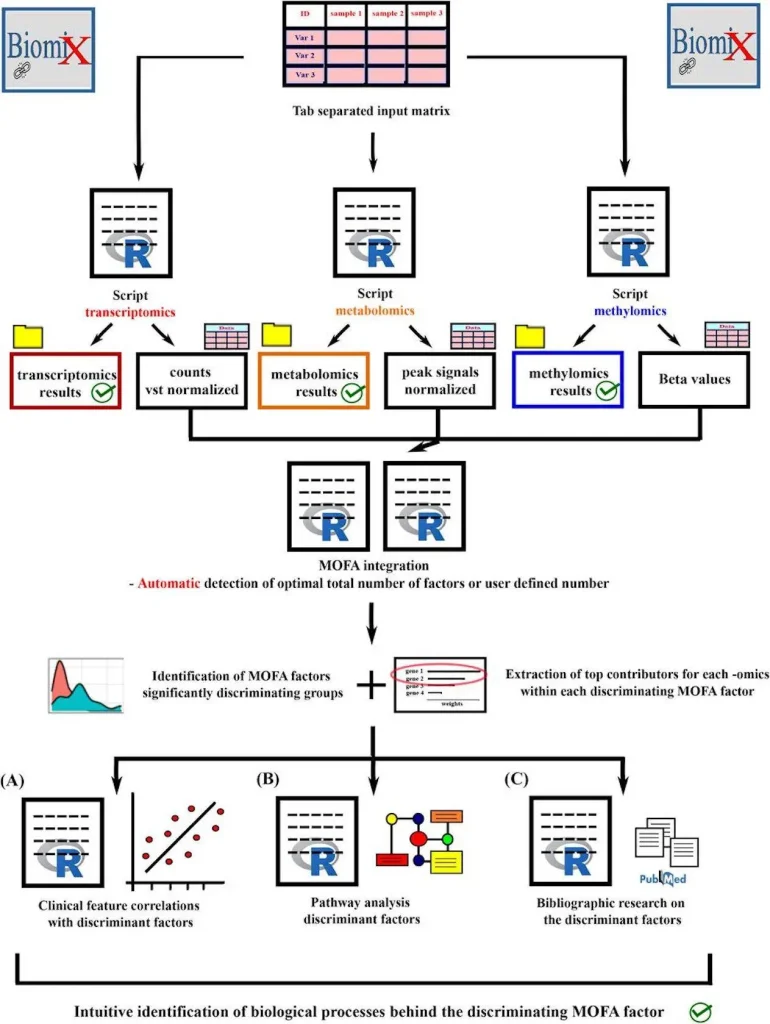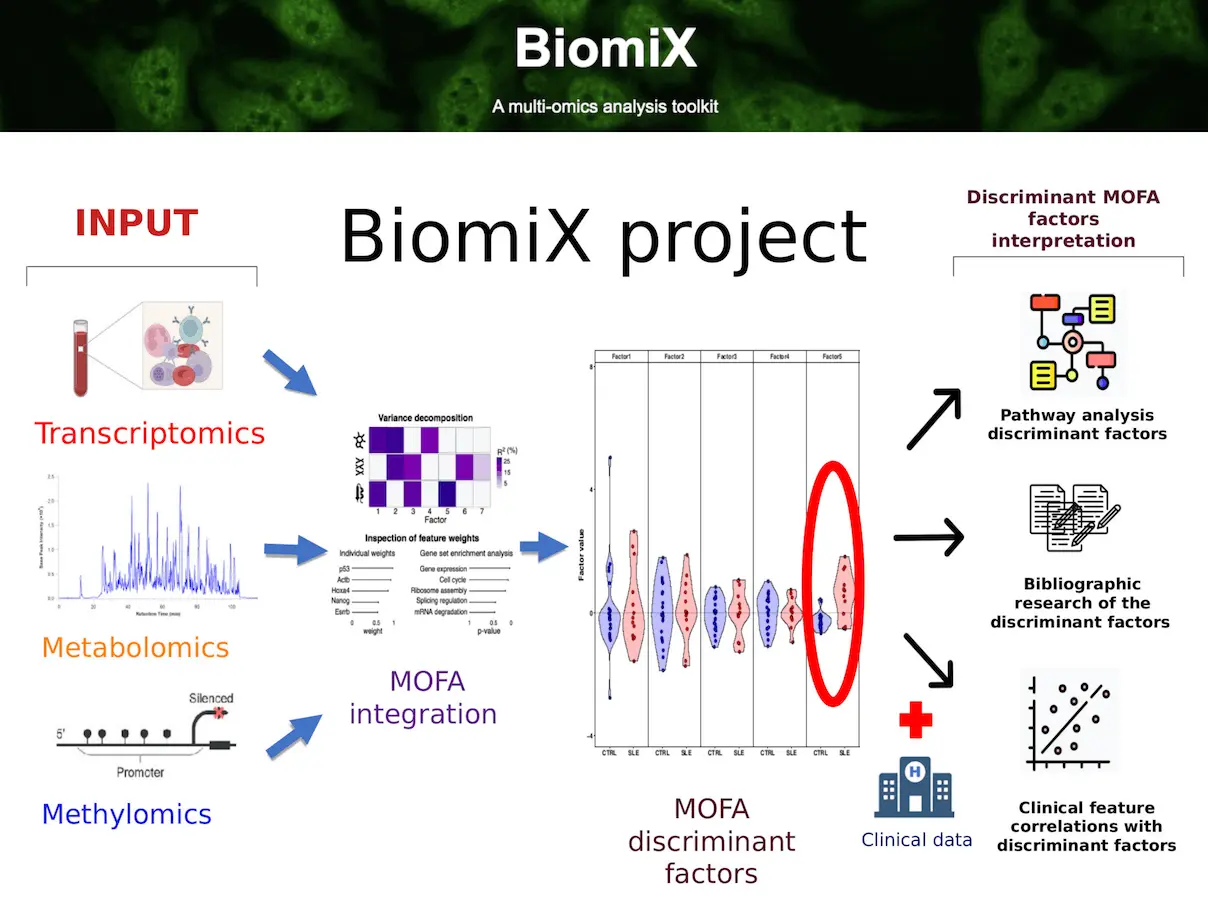A team of researchers from France and Spain designed BiomiX, a user-friendly bioinformatics tool for multiomics data analysis. BiomiX addresses the challenge of multiomics data analysis by enabling researchers to integrate and analyze data from various biological sources, even without much knowledge in bioinformatics. In this blog, we will examine how BiomiX simplifies the analysis process, uses advanced techniques to unlock biological insights, and helps researchers use multi-omics data.
Introduction
Biology is experiencing a data revolution. Data is generated at various biological levels like genomics/transcriptomics (genes and transcripts), metabolomics (metabolites), and methylomics (DNA methylation profile). This flood of data could be used to unravel complex biological systems and diseases. However, analyzing and interpreting this multiomics data can be challenging, especially for researchers without a strong bioinformatics background.
This is where BiomiX steps in by a group of scientists from France and Spain. It’s a user-friendly software tool explicitly made to relieve multi-omic data analysis bottlenecks.
Revealing the Might of Multi-omics Data
In the past, omics data analysis was done in isolation, focusing on a single type of data like gene expression (transcriptomics) or DNA methylation patterns (methylomics). However, life processes are intrinsically intricate and involve acts between different molecular layers. By blending information from various omics platforms, BiomiX gives a broader view of the biological system under scrutiny.
This is how BiomiX handles multi-omics data analysis:
Supports Different Kinds of Omics Data: BiomiX can deal with diverse data types obtained from multiple omics platforms, such as transcriptomics (RNA sequencing), metabolomics, and methylomics. This enables researchers to pool data obtained from different sources for comprehensive evaluation.
Simplified Analysis Workflow: BiomiX has automated most of the steps to conduct analysis, including normalization of data, statistical testing, and factor identification, among others. In this regard, researchers are not required to generate complex scripts or possess extensive bioinformatics skills.
Simple User Interface: It contains an easy-to-use graphical user interface (GUI) to guide the researchers throughout their analysis process. With just simple clicks, users can upload their datasets, choose the parameters for analysis, and read out what they meant without any code writing tasks.
Robust Single Omics Analysis: BiomiX has a robust set of validated pipelines for each data type for researchers who like to analyze single omics. These include sample subgrouping analysis, gene ontology enrichment, efficient data visualization, and more.

Beyond Automation: Unveiling Biological Insights
BiomiX does more than automate the analysis. It also provides functionalities that are specifically tailored to help researchers make sense of their multi-omics data and uncover biological insights:
Multiomics Factor Analysis (MOFA): BiomiX applies MOFA, a powerful statistical technique, to identify the underlying factors driving variation across diverse types of omics data, indicating the core biological processes that impact the system being studied.
Automatic MOFA Model Selection: This relieves researchers from manually tuning parameters like several factors in the MOFA model by automatically choosing the best settings; it guarantees that they get the most relevant information from their data.
The Literature-based Factor Interpretation: BiomiX has a new feature that looks automatically in PubMed, an enormous scientific literature database, to find research papers about the genes contributing to each MOFA factor. This gives researchers a stepping stone towards understanding the biological significance of these factors.
Clinical Data Correlation: Clinical data can be integrated into multiomics analysis using BiomiX, letting users know how the identified MOFA factors are related to clinical phenotypes or disease states.
Pathway Analysis: Pathway analysis is done by BiomiX for the genes associated with the most significant MOFA factors. This helps researchers know what biological pathways may be involved in these processes.
Customizable Analysis: BiomiX enables researchers to adjust their analysis as needed by providing numerous parameters and options. Users can limit their analysis depending on their specific question and data type.
BiomiX: A Boon for Life Science Researchers
When it comes to life sciences, BiomiX is a complete game-changer. This means that multi-omics analysis is no longer inaccessible to researchers who may not possess extensive knowledge in bioinformatics. BiomiX can be used by any researcher regardless of their skills in bioinformatics, thereby democratizing the field of multiomics analysis. As opposed to researchers lacking expertise in bioinformatics, BiomiX is designed for all scientists with or without much experience handling biological information to engage with omics data effectively.
Some new features embodying clinical data correlation and literature-based factor interpretation distinguish BiomiX, unlike other approaches, automate complex steps and provide user-friendly interfaces. These could be instrumental in enabling researchers using BiomiX to extract insightful biological information from their datasets. Such revelations will accelerate scientific discovery across diverse fields, such as personalized therapy development and understanding the causes of diseases at a molecular level. BiomiX is open-source software that promotes collaboration and continuous improvement among bioinformaticians.
Join the Conversation!
BiomiX is an open-source platform that enables researchers to contribute to its development and explore additional features. If you are a researcher interested in multi-omics analysis, we invite you to discover BiomiX and tell us your experience in bioinformatics.
Together, let’s fully exploit multi-omics information to further our knowledge of biology! Comment your thoughts below.
Article Source: Reference Paper | BiomiX’s download and tutorial are available on GitHub and the Webpage.
Important Note: bioRxiv releases preprints that have not yet undergone peer review. As a result, it is important to note that these papers should not be considered conclusive evidence, nor should they be used to direct clinical practice or influence health-related behavior. It is also important to understand that the information presented in these papers is not yet considered established or confirmed.
Follow Us!
Learn More:
Anchal is a consulting scientific writing intern at CBIRT with a passion for bioinformatics and its miracles. She is pursuing an MTech in Bioinformatics from Delhi Technological University, Delhi. Through engaging prose, she invites readers to explore the captivating world of bioinformatics, showcasing its groundbreaking contributions to understanding the mysteries of life. Besides science, she enjoys reading and painting.
















